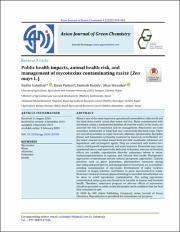Public health impacts, animal health risk, and management of mycotoxins contaminating maize (Zea mays L.)
(ندگان)پدیدآور
Gahatraj, SachinPariyar, KiranRasaily, SantoshShrestha, Jibanنوع مدرک
TextReview Article
زبان مدرک
Englishچکیده
Maize is one of the most important agricultural commodities in the world and the third most traded cereal after wheat and rice. Maize contaminated with mycotoxin causes a fundamental problem all over the world. In this study, we assessed the risk of mycotoxin and its management. Mycotoxins are toxic secondary metabolites of fungi that may contaminate the food crops. There are several mycotoxins in crops; however, aflatoxins (produced by Apergillus flavus) and fumonisins (primarily produced by Fusarium verticillioides) are the major concern in maize-based food and feed worldwide. Aflatoxins are hepatotoxic and carcinogenic agents. They are associated with human liver cancer, child growth impairment, and acute toxicoses. Fumosinin may cause esophaseal cancer and neural tube defection in humans, whereas in livestock effects are variable; reproductive disorder, pulmonary edema in swine, leukoencephalomalacia in equines, and reduced feed intake. Management approaches of mycotoxins include cultural and genetic approaches. Cultural practices such as plant quarantine, phytosanitary measures during harvesting and post harvest, and management of insect pest are essential for avoiding contamination of mycotoxin. Development of maize varieties resistant to fungal infection contributes to grow mycotoxins-free maize. Moreover, chemical removal, physical binding or microbial detoxification can be done to avoid mycotoxins contamination. The eating mycotoxins contaminated maize grain was found to be harmful to human and livestock health.Therefore, awareness program on adverse effects of mycotoxins should be provided to public so that the people can be confident that the food they consumed is safe.
کلید واژگان
Mycotoxinsmaize
Aflatoxins
Fumosinin
Health
شماره نشریه
4تاریخ نشر
2020-10-011399-07-10
ناشر
Sami Publishing Companyسازمان پدید آورنده
Faculty of Agriculture, Agriculture and Forestry University (AFU), Rampur, Chitwan, NepalMinistry of Agriculture and Livestock Development (MoALD), Kathmandu, Nepal
National Oilseed Research Program, Nepal Agricultural Research Council (NARC), Nawalpur, Sarlahi, Nepal
Agriculture Botany Division (ABD), Nepal Agricultural Research Council (NARC), Khumaltar, Lalitpur, Nepal
شاپا
2588-58392588-4328





